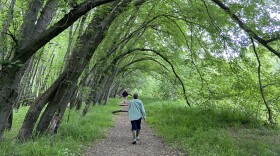If you get out into the woods, or even in your backyard or a park, you’ll notice all kinds of fungi this fall — thanks to our extraordinarily wet summer. And while you don’t have to pick the mushrooms, they are fun to photograph and examine up close.
In fact, all the photos in this article were taken by New Hampshire Audubon staff during a one-hour “mushroom blitz” outing in September.
We are just beginning to learn how amazing fungi are. Neither plants nor animals, they’re a kingdom all their own.
Fungi likely helped early plant life survive on Earth. Just a few years ago, scientists found a billion year-old fossil fungus in the Canadian arctic. Many plants, like the pink lady’s slipper, still can’t survive without their underground fungal partners.
The mushrooms that we see are just the tip of the iceberg: visible fruiting bodies for a huge underground network of microscopic strands right underfoot. Some people even call it the “wood wide web.”

Fungi in the soil interact with trees to form intricate relationships called “mycorrhizae.” Strands of fungus merge with fine tree roots. On the microscopic level, it’s difficult to tell where the plant root ends and the fungus begins.
Trees trade sugars – carbohydrates – to feed the fungi, and in turn trees benefit from the increased root-fungus surface area, collecting water and nutrients to fuel tree growth.
In undisturbed forest soils, fungal diversity increases with forest age, demonstrating the symbiotic connection between fungi and forest health.
So if all that’s happening underground, what’s the mushroom part for?
The function of a mushroom is to reproduce, releasing spores that contain DNA from gills or pores on the underside of the mushroom’s cap. Spores drop onto the soil or are dispersed by wind.
Think of the cloud that appears when you stomp on a puffball. That “smoke” is really a cloud of spores. Worldwide, there are tens of thousands of types of spore-producing molds and fungi.
But other varieties, like truffles, grow entirely underground. They don’t rely on the wind to disperse their spores.
Instead, chipmunks, deer, and other forest dwellers dig up and eat the truffles, and then spread spores through their scat. Scattered across the woods, these spores start new fungal strands. Not only do they enrich the soil, but they combine with neighboring strands and reproduce that way.
In many cultures people have consumed common edible mushrooms for centuries. Varieties like reishi (hemlock varnish shelf fungus), lion’s mane (Hericium), and hen of the woods (Maitake) have antioxidant, anti-inflammatory, and possibly anti-cancer benefits.
And scientists now say that fungi are responsible for helping maintain the global carbon balance, storing and using carbon in their underground mycorrhizal networks to the tune of more than 13 billion metric tons of CO2 – more than one third of all annual global fossil fuel emissions!
We’re really just starting to understand the true value of fungi. To paraphrase Harvard ecologist and entomologist E.O. Wilson: science has yet to turn its full attention to the microscopic wilderness in a single teaspoon of forest soils in any typical forested backyard.

Get outside before winter and see what fungi you can find! And use your imagination If you are exploring with kids; you can imagine the vivid colors and textures of fungi could be the abode of gnomes or fairies.
Something Wild is a partnership of the Forest Society, NH Audubon, and NHPR.











